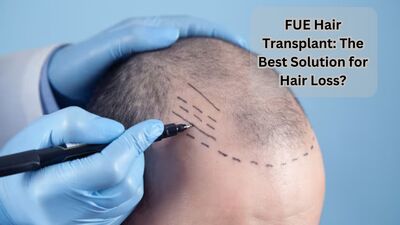Categories
Tags
Archives
FUE Hair Transplant: The Best Solution for Hair Loss?
-
Millions of men and women worldwide suffer from the common hair loss problem. Hair thinning can significantly impact self-confidence due to genetics, hormonal imbalances, or lifestyle factors. Fortunately, advancements in hair restoration have made it possible to regain a full, natural-looking head of hair. One of the most popular and effective procedures is FUE in hair transplant, a minimally invasive technique that offers permanent results. But is FUE truly the best solution for hair loss? Let’s explore this procedure in depth.
What is FUE Hair Transplant?
Follicular Unit Extraction (FUE) is a modern hair transplant technique that involves extracting individual hair follicles from a donor area—typically the back or sides of the scalp—and implanting them into areas affected by hair loss. The procedure starts with the surgeon shaving the donor area and utilizing a micro-punch tool to extract individual hair follicles. These follicles are then meticulously implanted into tiny incisions in the recipient area. Over time, the transplanted hair grows naturally, blending seamlessly with existing hair.
Benefits of FUE Hair Transplant
- Minimally Invasive & No Linear Scarring: FUE hair transplants are an excellent choice for people who appreciate short hairstyles because they don't leave any visible scars as FUT does.
- Natural-Looking Results: Since follicles are extracted and implanted individually, the results mimic hair's natural growth pattern.
- Faster Recovery Time: Within a few days, the majority of patients can resume their regular activities.
- Suitable for Various Areas: Besides the scalp, FUE in hair transplant can also be used to restore hair on the beard, eyebrows, and chest hair.
- Long-Term Effectiveness: Once the transplanted hair starts growing, it remains permanent, requiring no additional maintenance besides regular hair care.
Who is a Good Candidate for FUE?
While FUE is a great hair transplant option for many people, not everyone is a good fit. The top contenders are:
- People whose scalps have enough donor hair
- Those experiencing pattern baldness
- Patients looking for a less invasive alternative to FUT
- People with realistic expectations regarding the results
People who suffer from severe scalp diseases or uncontrolled diabetes, for example, might not be good candidates. Determining eligibility might be aided by speaking with a hair restoration specialist.
Potential Risks and Considerations
As with any medical procedure, FUE in hair transplant carries potential risks. These include:
- Temporary Swelling & Redness: Mild swelling and redness around the treated areas are common but subside within a few days.
- Shock Loss: Some patients may notice temporary hair shedding before new growth starts.
- Infection or Poor Graft Survival: Although rare, improper post-operative care can lead to disease or graft failure.
- Cost Considerations: The price of FUE in hair transplants varies based on the number of grafts needed and the clinic’s expertise.
Recovery and Aftercare
Proper post-operative care is essential for optimal FUE hair transplant results. Here’s what you can expect:
- First Few Days: Mild swelling and scabbing may occur. Avoid touching or scratching the scalp.
- One to Two Weeks: Small scabs fall off naturally. Patients can resume light physical activities.
- Three to Four Months: New hair growth begins, though some initial shedding is normal.
- Six to Twelve Months: Full results become visible as the transplanted hair thickens and blends naturally.
Following the surgeon’s aftercare instructions, such as avoiding sun exposure and refraining from strenuous activities, ensures optimal healing and hair growth.
Success Stories and Results
Many individuals who undergo FUE in hair transplant report high satisfaction with their results. Before-and-after photos often showcase significant improvements in hair density and hairline restoration. Real patient testimonials showcase how FUE has restored their confidence and enhanced their overall appearance.
Conclusion
FUE is undoubtedly one of the most advanced and effective hair restoration methods. Its minimally invasive approach, natural results, and long-term effectiveness make it a top choice for individuals experiencing hair loss. However, the best treatment depends on individual needs, hair loss patterns, and medical history. Consulting with a reputable clinic is crucial for those considering FUE in hair transplant. Beverly Hills Hair Restoration specializes in FUE, utilizing advanced techniques and personalized care to help patients achieve their ideal hair restoration results. Schedule a consultation today to take the first step toward a fuller, more confident look.





